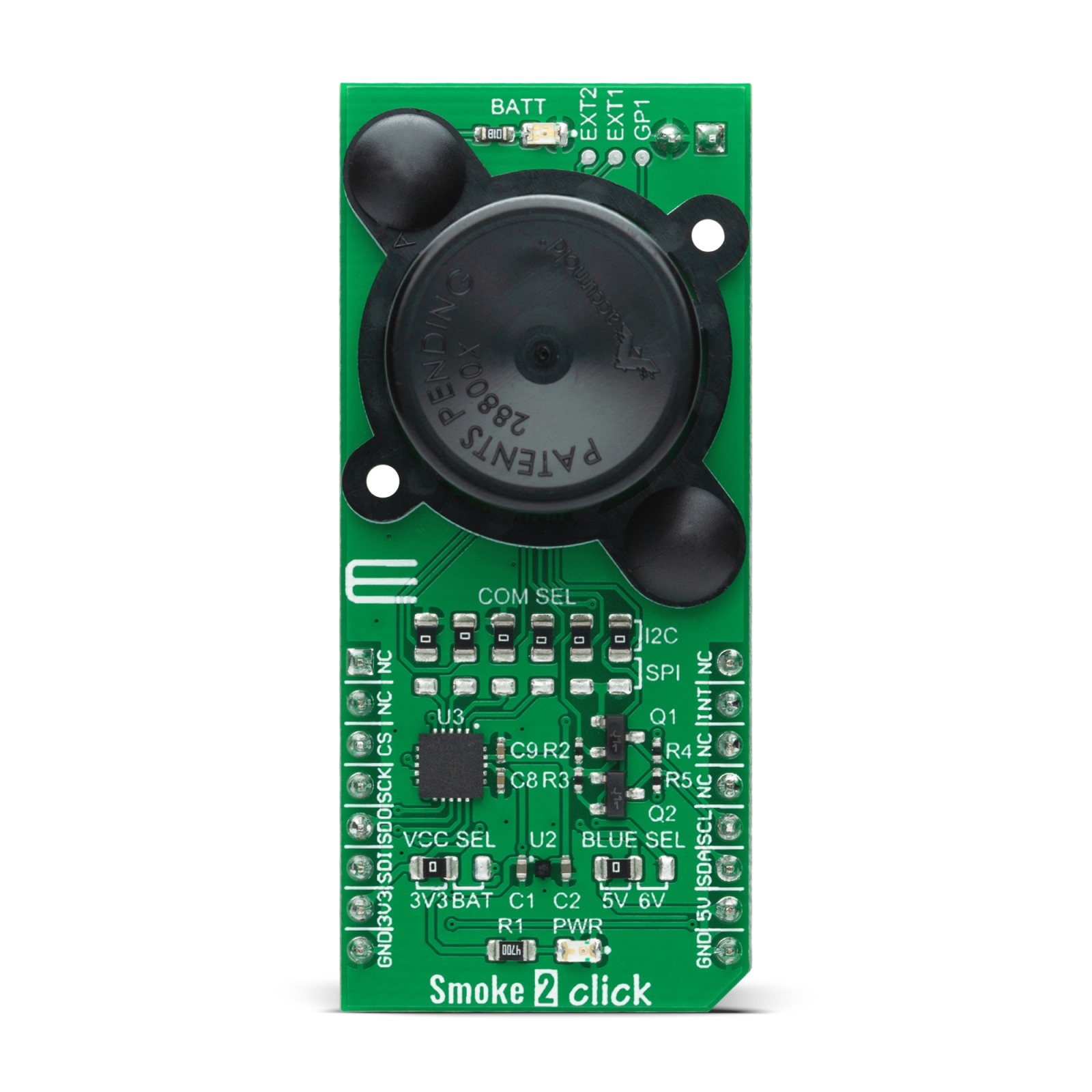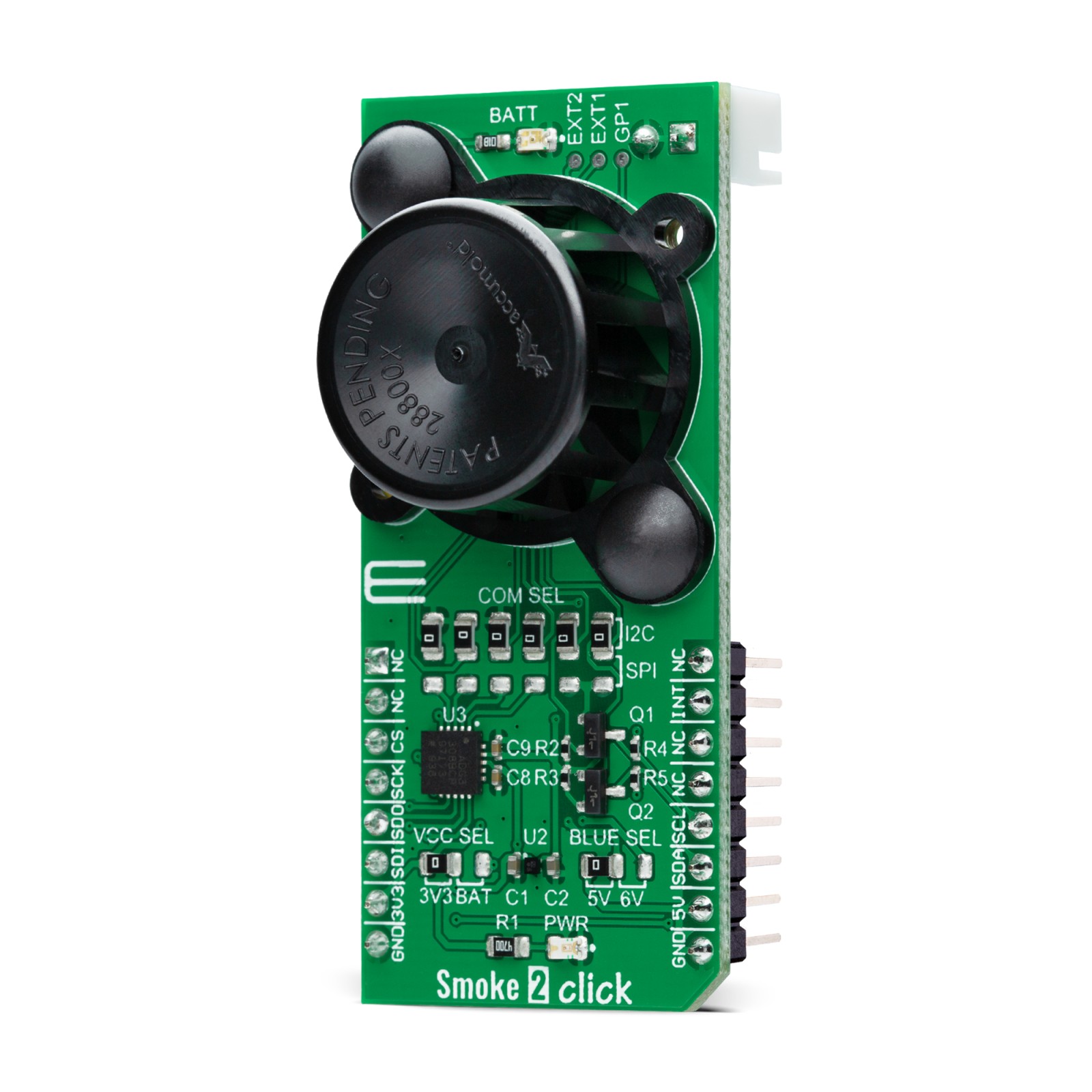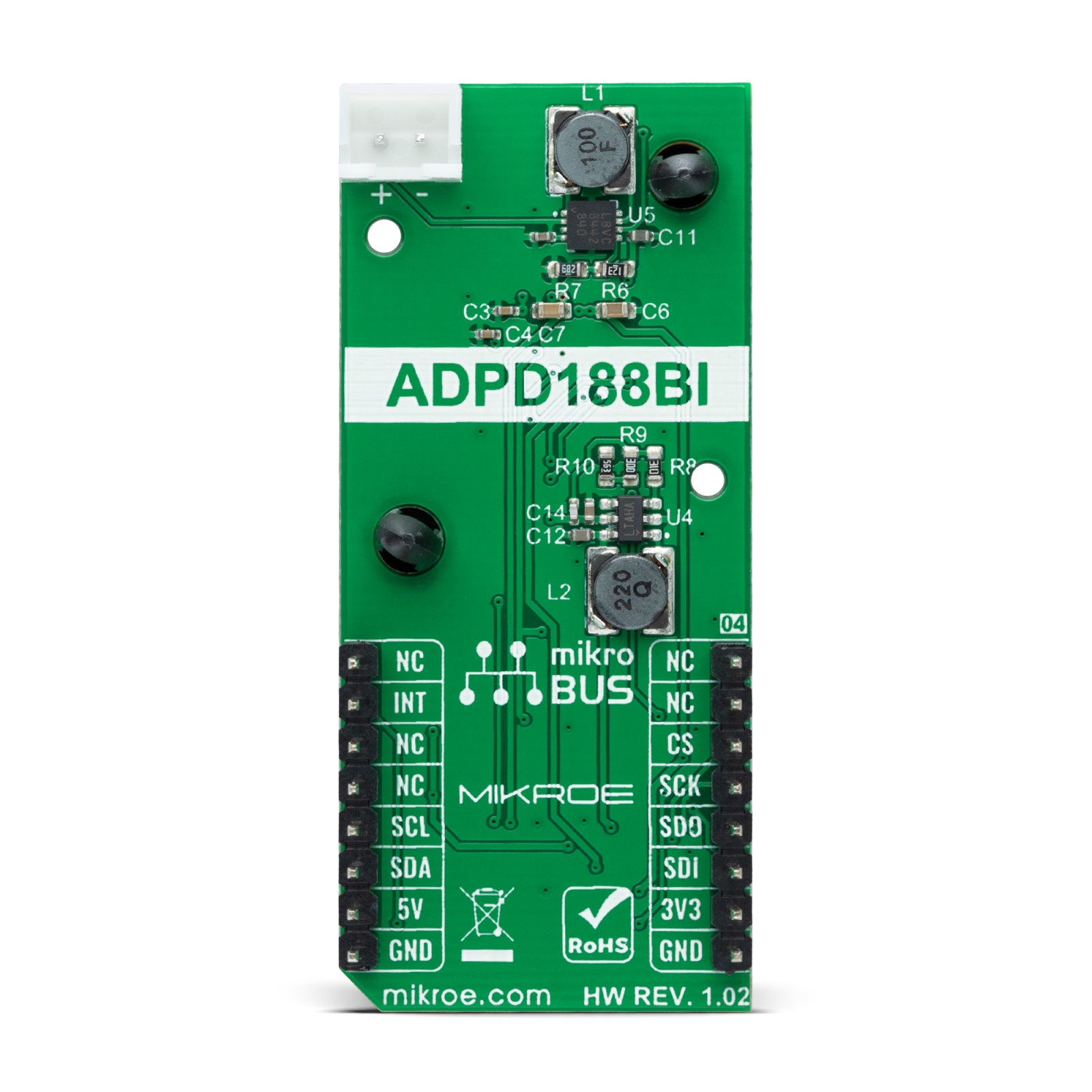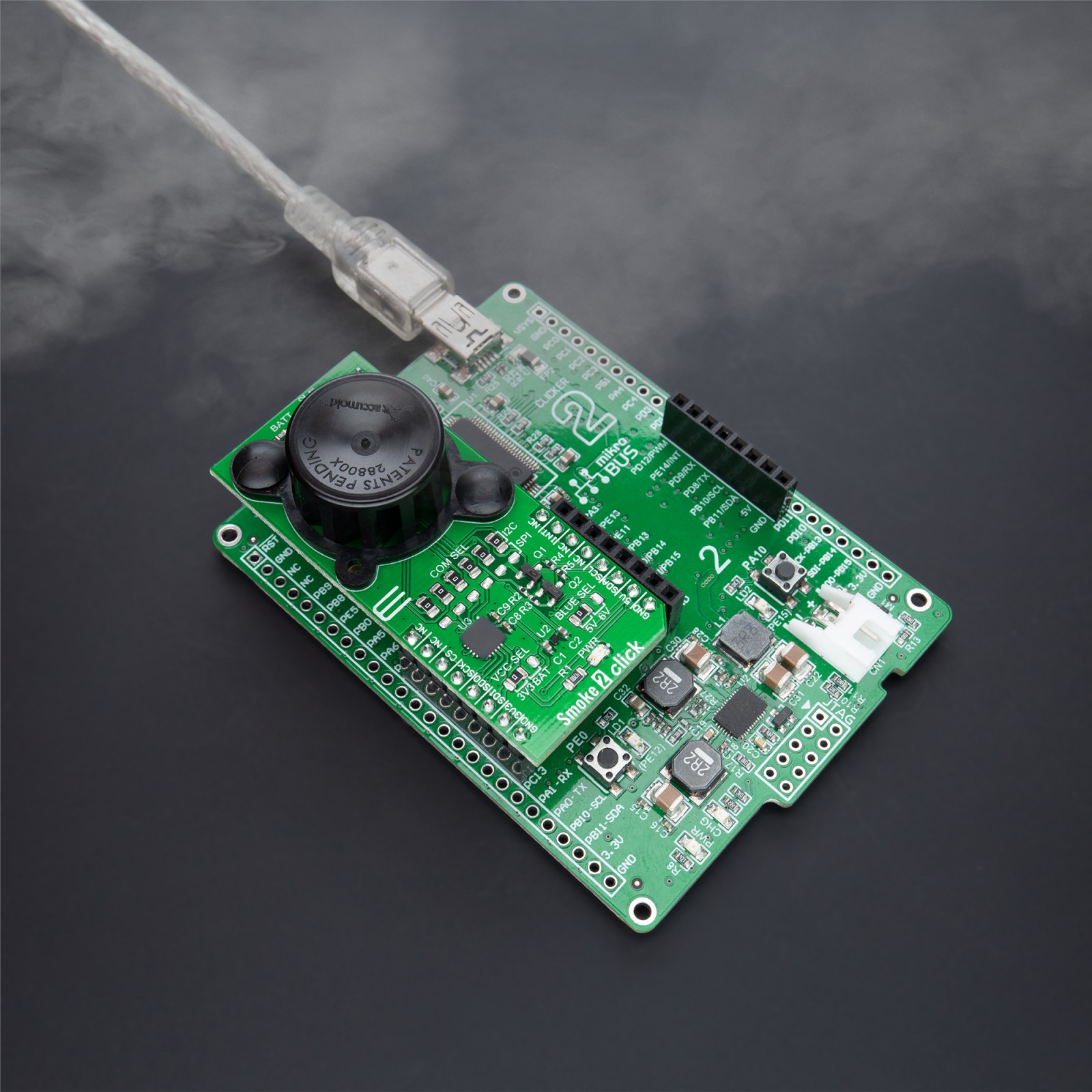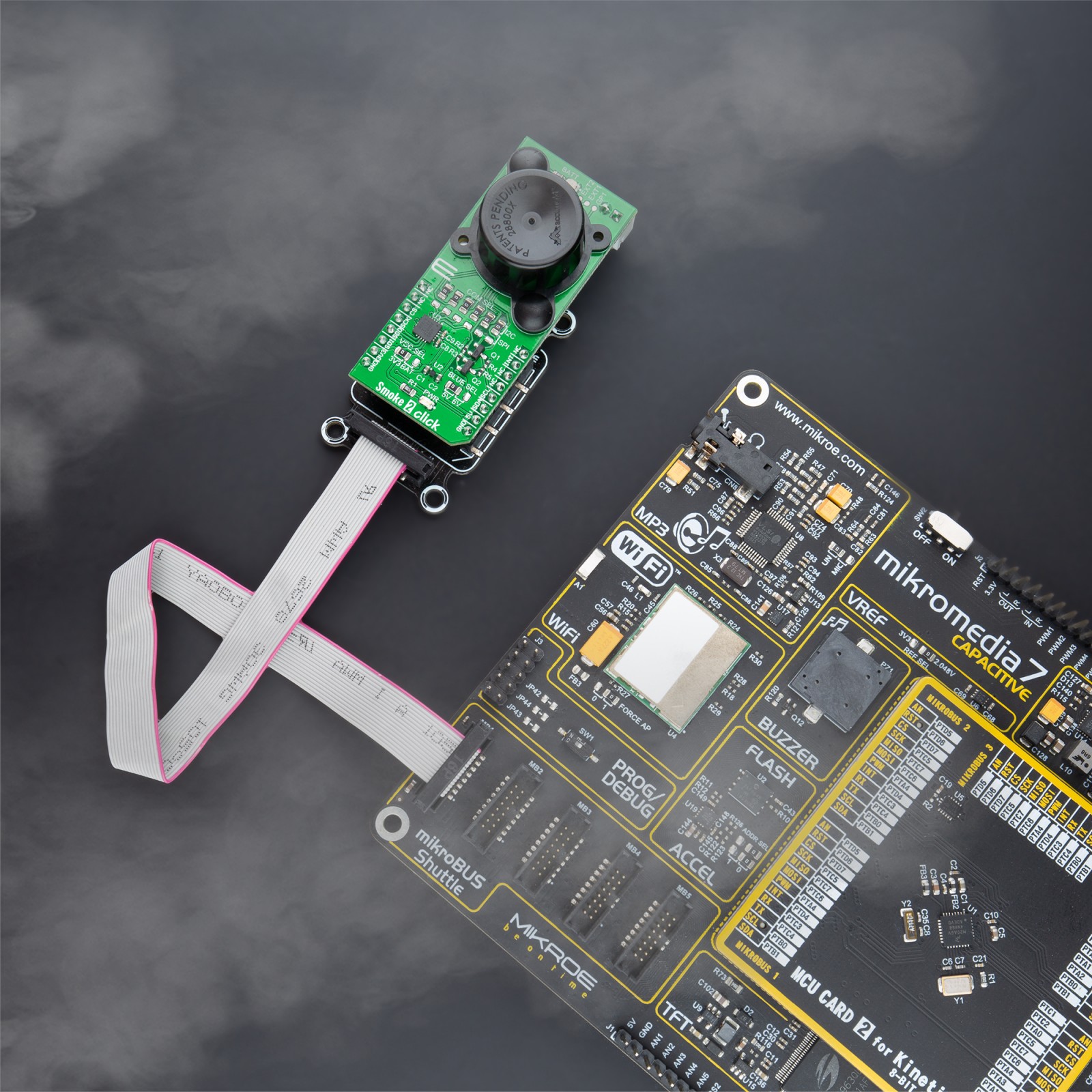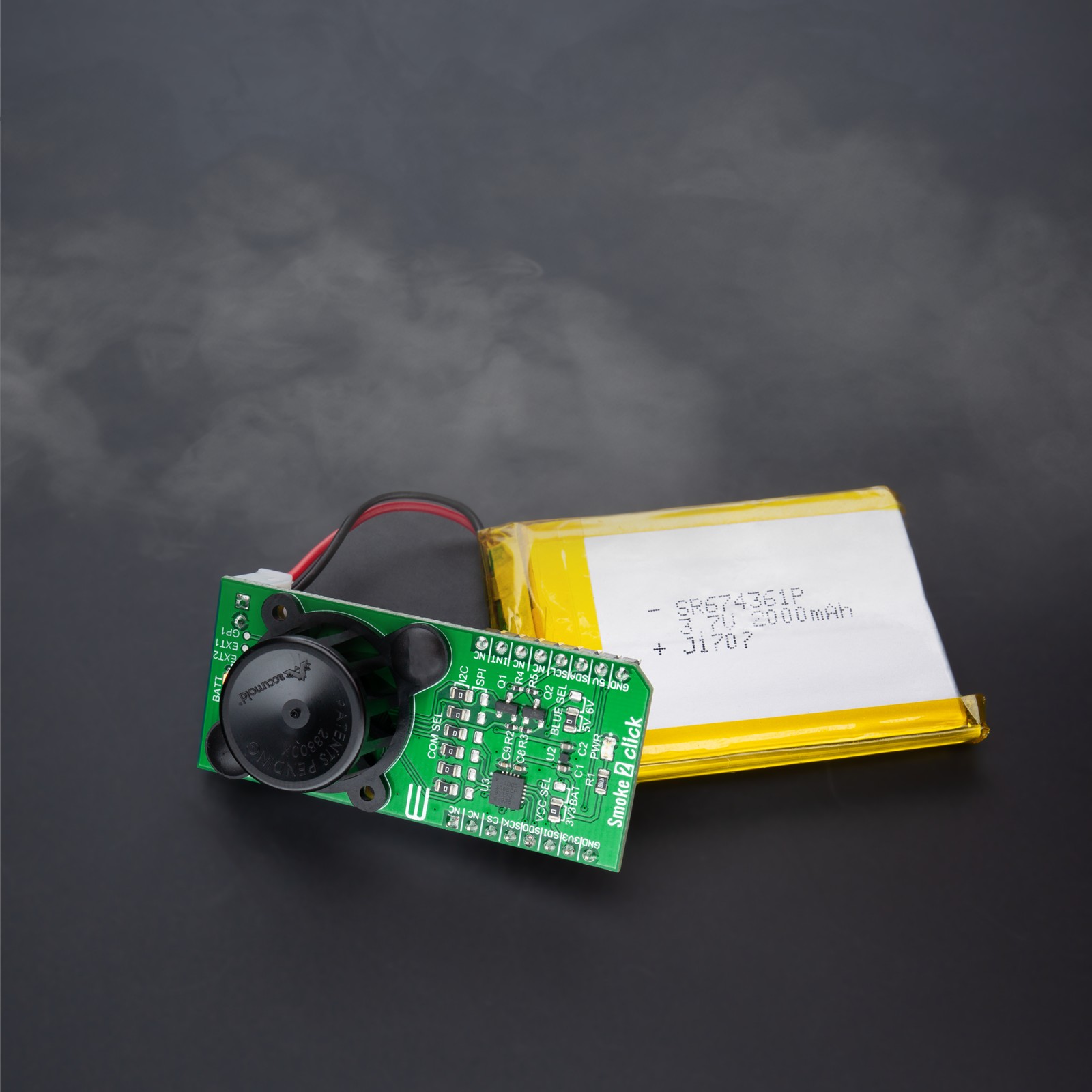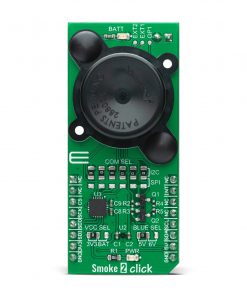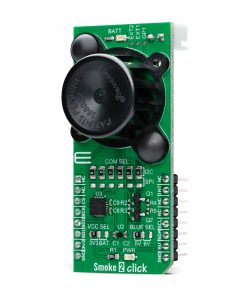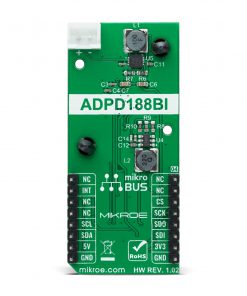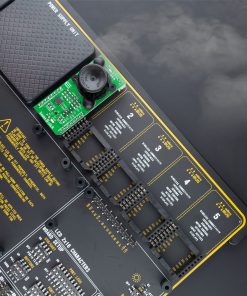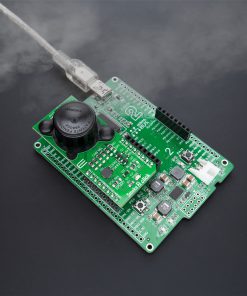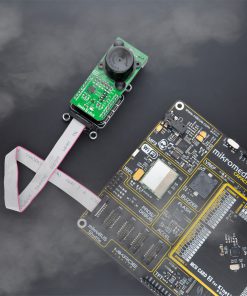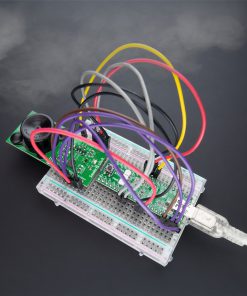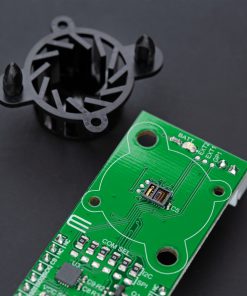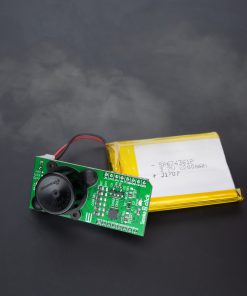Subtotal: R1,300.00
Smoke 2 Click
R1,400.00 ex. VAT
Smoke 2 Click is a compact add-on board that contains the most efficient version of the smoke detector. This board features the ADPD188BI, a complete photometric system for smoke detection using optical dual-wavelength technology from Analog Devices. The module combines the dual photodetector with two separate LEDs and a mixed-signal photometric front-end ASIC, housed in a package that prevents light from going directly from the LED to the photodiode, without first entering the smoke detection chamber. It supports both an SPI and I2C serial interface, although only one is allowed at any given time in the actual application. This Click board™ is suitable for application as smoke detector that is more architecturally compatible for residential and commercial use.
Smoke 2 Click is supported by a mikroSDK compliant library, which includes functions that simplify software development. This Click board™ comes as a fully tested product, ready to be used on a system equipped with the mikroBUS™ socket.
Stock: Lead-time applicable.
| 5+ | R1,330.00 |
| 10+ | R1,260.00 |
| 15+ | R1,190.00 |
| 20+ | R1,145.20 |
How does it work?
Smoke 2 Click is based on the ADPD188BI, a complete photometric system for smoke detection using optical dual-wavelength technology from Analog Devices. The module combines the dual photodetector with two separate LEDs and a mixed-signal photometric front-end ASIC, and prevents light from going directly from the LED to the photodiode without first entering the smoke detection chamber. The dual-wavelength combination in a scattering measurement, a 470nm blue LED and an 850nm IR LED, allows particle size discrimination between different types of smoke, dust, or steam. The core circuitry stimulates the LEDs and measures the corresponding optical return signals. This integrated solution enables low power and reduces false smoke alarms in harsh environments due to dust, steam, and other nuisance sources.
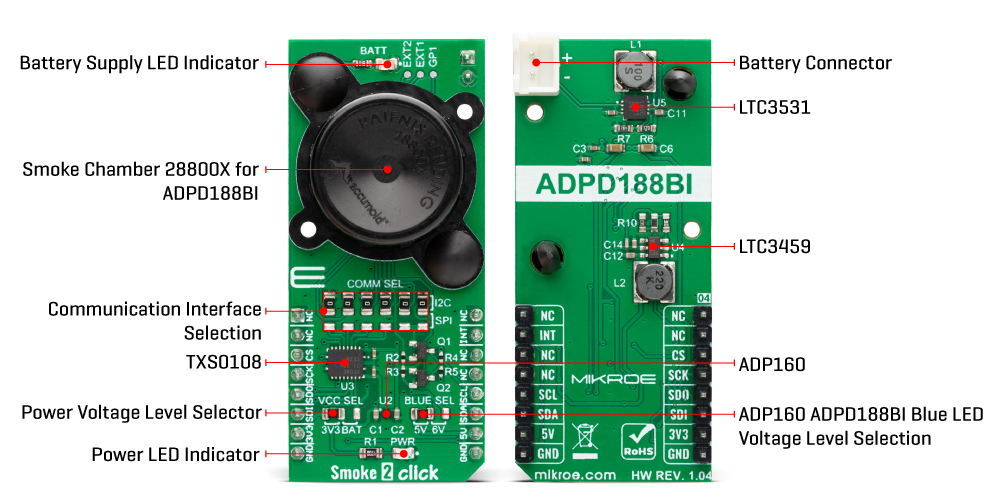
The smoke chamber 28800X is designed to be used with the ADPD188BI and minimize background response while controlling the environment around the ADPD188BI module by limiting dust accumulation and keeping out insects. The ADPD188BI registers a positive signal due to light scattering from the smoke chamber. Although the smoke chamber minimizes this positive signal, there is a nonzero response in the absence of smoke. When using a smoke chamber, this background response must be accounted for if you want to accurately measure the level of particles present in the smoke chamber.
The ADPD188BI operates in one of the following three modes: Standby, Program, or Normal Sampling Mode. Standby Mode is a power-saving mode in which data collection does not occur, while the Program Mode configures and program registers. During regular operation, the ADPD188BI pulses light and collects data, and in this mode, power consumption depends on the pulse count and data rate. Besides, the ADPD188BI also requires a supply voltage of 1.8V to work regularly. Therefore, a small regulating LDO, the ADP160 from Analog Devices, provides a 1.8V out of 3.3V mikroBUS™ rail, or optionally, from a battery power source.
The output from the LDO regulator provides a needed voltage for one side of the TXS0108, an 8-bit bidirectional level translator from Texas Instruments, while the voltage for the other side of the level translator is delivered from the VCC SEL jumper. Also, this Click board™ may be battery-powered, indicated via an LED indicator labeled as BATT, and used as a stand-alone device. It has LTC3531, a synchronous buck-boost DC/DC converter also from Analog Devices, allowing battery voltage to be converted to 3.3V and used in a selection of voltage needed to be converted by ADP160 to supply ADPD188BI.
Smoke 2 Click provides the possibility of using both I2C and SPI serial interfaces, although only one is allowed at any given time in the actual application. All internal registers of the ADPD188BI are accessed through the selected communications interface. I2C supports Fast mode with data transfer of 400 kbps, while SPI interface support frequency up to 10MHz. This selection can be performed by positioning SMD jumpers labeled as COMM SEL to an appropriate position. Note that all the jumpers must be lined to the same side, or else the Click board™ may become unresponsive.
Additionally, test points, located in the upper part on the top side of the board, for pins EXT_IN1, EXT_IN2 and GPIO1 allow users to plug in external sensors like thermistor into the EXT pins and to use GPIO1 pin for some digital functionality. The EXT_IN1 and EXT_IN2 pins are also current inputs that can be connected to external sensors. A voltage source can be connected to the EXT_IN1 and EXT_IN2 pins through a series resistance, effectively converting the voltage into a current. Other test points for LED1, LED2, LED3 pins can be found under the smoke chamber on the top side of the board if users want to plug in their LEDs and not use the internal LEDs.
The user also has the option to select the voltage for the blue LED of the ADPD188BI, which can be selected via the BLUE SEL jumper in order to analyze the characteristics with the recommended and maximum values. This diode can be powered by a maximum of 6V achieved by LTC3459 from Analog Devices.
Optionally, the Smoke 2 Click board™, in addition to the mikroBUS™ power supply, can also be powered from an external battery. The battery power supply section is designed to power ADPD188BI and fulfill the demand for a complete solution, including the microcontroller and short-range radio power needs.
This Click board™ can be operated only with a 3.3V logic voltage level, supplied via mikroBUS™ or battery power, selected via the VCC SEL jumper. The board must perform appropriate logic voltage level conversion before use with MCUs with different logic levels. However, the Click board™ comes equipped with a library that contains functions and an example code that can be used, as a reference, for further development.
Specifications
Type
Optical
Applications
Can be used for application as smoke detector that is more architecturally compatible for residential and commercial use.
On-board modules
ADPD188BI – complete photometric system for smoke detection using optical dual-wavelength technology from Analog Devices ADP160 – small regulating LDO from Analog Devices TXS0108- 8-bit bidirectional level translator from Texas Instruments LTC3531 – synchronous buck-boost DC/DC converter from Analog Devices LTC3459 – synchronous boost converter from Analog Devices
Key Features
Low power consumption, high precission, integrates a highly efficient photometric front end, two light emitting diodes, and two photodiodes, equipped with smoke detection chamber, optimized SNR for signal limited cases, and more.
Interface
I2C,SPI
Feature
No ClickID
Compatibility
mikroBUS™
Click board size
L (57.15 x 25.4 mm)
Input Voltage
3.3V,5V,External
Pinout diagram
This table shows how the pinout on Smoke 2 Click corresponds to the pinout on the mikroBUS™ socket (the latter shown in the two middle columns).
Onboard settings and indicators
| Label | Name | Default | Description |
|---|---|---|---|
| LD1 | PWR | – | Power LED Indicator |
| LD2 | BATT | – | Battery Supply LED Indicator |
| JP1 | VCC SEL | Left | Logic Level Voltage Selection 3V3/BAT: Left position 3V3, Right position BAT |
| JP2-JP7 | COMM SEL | Up | Communication Interface Selection SPI/I2C: Left position SPI, Right position I2C |
| JP8 | BLUE SEL | Left | ADPD188BI Blue LED Voltage Level Selection 5V/6V: Left position 5V, Right position 6V |
Smoke 2 Click electrical specifications
| Description | Min | Typ | Max | Unit |
|---|---|---|---|---|
| Supply Voltage | – | 3.3 | – | V |
| Blue LED Wavelenght | – | 470 | – | nm |
| IR LED Wavelenght | – | 850 | – | nm |
Software Support
We provide a library for the Smoke 2 Click as well as a demo application (example), developed using MIKROE compilers. The demo can run on all the main MIKROE development boards.
Package can be downloaded/installed directly from NECTO Studio Package Manager (recommended), downloaded from our LibStock™ or found on MIKROE github account.
Library Description
This library contains API for Smoke 2 Click driver.
Key functions
-
smoke2_get_int_pinThis function eget state of int pin of Smoke 2 click board. -
smoke2_write_dataThis function is generic for writing data to register of Smoke 2 click board. -
smoke2_read_dataThis function is generic for reading data from registar of Smoke 2 click board.
Example Description
This example is made to see how Smoke 2 clicks work. The purpose of this example is that, depending on the way we choose, it collects data from the external environment about smoke, processes it, and prints it via the UART terminal.
void application_task ( void )
{
#if ( EXAMPLE_MODE == EXAMPLE_MODE_SMOKE )
smoke_example( &smoke2 );
#elif ( EXAMPLE_MODE == EXAMPLE_MODE_PROXIMITY )
proximity_example( );
#endif
}
The full application code, and ready to use projects can be installed directly from NECTO Studio Package Manager (recommended), downloaded from our LibStock™ or found on MIKROE github account.
Other MIKROE Libraries used in the example:
- MikroSDK.Board
- MikroSDK.Log
- Click.Smoke2
Additional notes and informations
Depending on the development board you are using, you may need USB UART click, USB UART 2 Click or RS232 Click to connect to your PC, for development systems with no UART to USB interface available on the board. UART terminal is available in all MIKROE compilers.
mikroSDK
This Click board™ is supported with mikroSDK – MIKROE Software Development Kit. To ensure proper operation of mikroSDK compliant Click board™ demo applications, mikroSDK should be downloaded from the LibStock and installed for the compiler you are using.
For more information about mikroSDK, visit the official page.
Resources
Downloads
| Weight | 22 g |
|---|---|
| Brand | MikroElektronika |

 GSM-GPS Click
GSM-GPS Click 